Comments / Questions (33)
![]() Janneke wrote:
Janneke wrote:
Vill använda 1 tråd Drops Melody istället. 400gr Alpaca 3 trådar får jag till 446 meter Melody dvs 160 gr. Har jag räknat/tänkt rätt?
31.07.2019 - 19:59DROPS Design answered:
Hej Janneke, ja det lyder rigtigt. God fornøjeles! :)
01.08.2019 - 15:13
![]() Gabriela wrote:
Gabriela wrote:
Hello I started to make the cape. But I got stuck at row 1. ROW 1: ch 7 (= 1 dtr + 2 ch). In 3rd dc from mid front crochet as follows: 1 dtr, ch 2 and 1 dtr, * ch 3, skip 4 dc. In next dc crochet as follows: 1 dtr, ch 2 and 1 dtr *, repeat from *-* until 3 dc remain, finish with ch 2 and 1 dtr in last dc, turn. Where I have to do the mid front crochet? Thank you x
08.02.2019 - 17:02DROPS Design answered:
Dear Gabriela, hte 3rd dc from mid front is the 3rd stitch from edge (beg of previous row). Happy crocheting!
11.02.2019 - 07:54Mercedes wrote:
Muy lindo la capa !!! Gracias
22.06.2018 - 04:17
![]() Marga Raps wrote:
Marga Raps wrote:
Hallo, ik wil deze cape graag maken met big Marino. Kan dat? En zo ja, hoeveel garen heb ik nodig. Dit kon niet berekend worden op jullie site. Alvast bedankt voor het antwoord!
05.05.2018 - 15:14DROPS Design answered:
Hallo Marga, Dit patroon wordt met 3 draden Alpaca (categorie A) gehaakt. Als je met Big Merino haakt gebruik je, neem ik aan 1 draad en waarschijnlijk is de stekenverhouding dan anders. Waarschijnlijk heb je iets meer nodig met een dikker garen, maar je kunt je verkooppunt vragen of je overgebleven bollen terug kunt sturen. Een andere optie is om met 3 draden Baby Merino te haken.
06.05.2018 - 11:28M L wrote:
Can I use one thread instead of 3?
21.03.2018 - 14:27DROPS Design answered:
Dear M L, sure, you will find all relevant informations about alternatives there. Happy crocheting!
21.03.2018 - 15:23M L wrote:
Hi, what is meant by 'with 3 threads' under DROPS CROCHET HOOK ... just under the materials paragraph? I know this line tells me the tension to get the size but not sure about the 3 threads part. Thank you.
21.03.2018 - 10:52DROPS Design answered:
Dear M L, you will work with 3 strands Alpaca worked together as just one (= with 1 end of 3 balls at the same time). Happy crocheting!
21.03.2018 - 13:31
![]() Lucia wrote:
Lucia wrote:
Vorrei realizzare questa mantellina con un colletto. potreste darmi un'indicazione su come farlo? grazie.
11.11.2017 - 16:37DROPS Design answered:
Buonasera Lucia, per ricevere un aiuto personalizzato può rivolgersi al suo rivenditore DROPS di fiducia. Buon lavoro!
11.11.2017 - 18:43Elvia Sanchez Saraoz wrote:
Donde encuentro el patron en video. por favor.
28.07.2016 - 19:49DROPS Design answered:
Hola Elvia, los videos explicativos de algunos pasos se encuentran publicados en el apartado videos que está al lado de los materiales.
31.07.2016 - 15:44Hafermehl Anneliese wrote:
Herzlichen dank für dieses schöne modell und die genaue beschreibung. damit konnte ich meiner freundin ein schönes geschenk anfertigen. ich bin begeistert davon, denn eigentlich bin ich eher auf das sticken fixiert. mit freundlichem gruß a. hafermehl
18.07.2016 - 10:24
![]() Peggy wrote:
Peggy wrote:
Where is 'favorites' button on the pattern page? I want to 'bookmark' but do not see any way of doing so?
21.12.2015 - 01:16DROPS Design answered:
Dear Peggy, you should get a red flag with a white heart at the top corner on the right side of the picture, click on this hear to add it in your favorites. Happy crocheting!
21.12.2015 - 11:23
Strands of Pearls#strandofpearlscape |
||||||||||||||||
 |
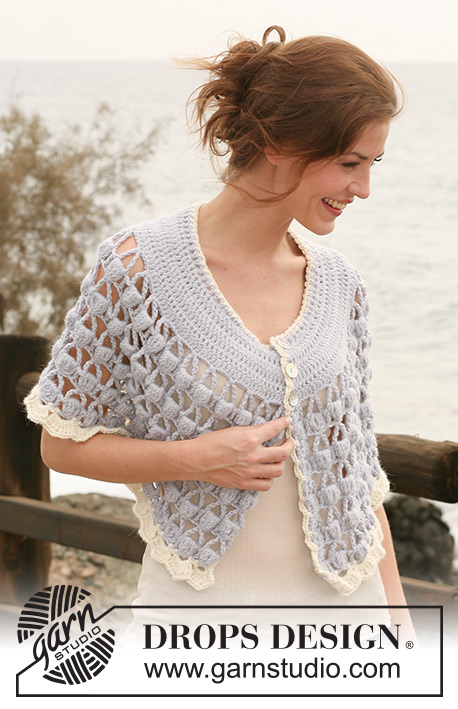 |
|||||||||||||||
Crochet DROPS cape with bobble pattern in ”Alpaca”. Size S/M-XXL/XXXL.
DROPS 119-30 |
||||||||||||||||
|
CROCHET INFO: At beg of row replace 1 dc with ch 3, 1 tr with ch 4 and 1 dtr with ch 5. INCREASING TIP: Inc 1 dc by working 2 dc in 1 dc. PATTERN: See diagram M.1. BOBBLE: Crochet 1 tr but wait with the last pull-through (= 2 sts on hook), crochet 7 tr in the same way in the same ch-loop (= 9 sts on hook), pull thread through all 9 sts, finish with 1 ch (= 1 ch on hook). -------------------------------------------------------- -------------------------------------------------------- CAPE: Crochet from neckline towards bottom edge. Crochet 85-90-95 loose ch (includes 4 ch to turn with) with hook size 5 mm / H/8 and 3 threads light steel blue. See CROCHET INFO above! ROW 1: Crochet 1 dc in 4th ch from hook, 1 dc in next ch, * skip 1 ch, 1 dc in each of the next 4 ch *, repeat from *-* until 5 ch remain, finish with skip 1 ch, 1 dc in each of the last 4 ch = 66-70-74 dc, turn piece. ROW 2: Ch 3 (= 1 dc), * 2 dc in next dc, 1 dc in next dc *, repeat from *-* until 1 dc remain, finish with 1 dc in last dc = 98-104-110 dc. ROW 3: Crochet 1 dc in each dc. ROW 4: Ch 3 (= 1 dc), * 2 dc in next dc, 1 dc in each of the next 2 dc *, repeat from *-* until 1 dc remain, finish with 1 dc in last dc = 130-138-146 dc. ROW 5: Crochet 1 dc in each dc. ROW 6: Ch 3 (= 1 dc), * 2 dc in next dc, 1 dc in each of the next 2 dc *, repeat from *-* until 0-2-1 dc remain, finish with 1 dc in each of the last dc = 173-183-194 dc. ROW 7: Crochet 1 dc in each dc, AT THE SAME TIME inc 8-8-7 dc evenly – see INCREASING TIP! = 181-191-201 dc. Crochet 0-1-2 rows with 1 dc in each dc. Piece now measures approx 10-11-13 cm / 4"-4⅜"-5⅛". Now continue in PATTERN as follows – see above: ROW 1: ch 7 (= 1 dtr + 2 ch). In 3rd dc from mid front crochet as follows: 1 dtr, ch 2 and 1 dtr, * ch 3, skip 4 dc. In next dc crochet as follows: 1 dtr, ch 2 and 1 dtr *, repeat from *-* until 3 dc remain, finish with ch 2 and 1 dtr in last dc, turn. ROW 2: ch 5 (= 1 tr + 1 ch), skip 2 ch and 1 dtr. In next 2-ch-loop crochet as follows: * 1 BOBBLE - see above - ch 1, 1 tr in 3-ch-loop, ch 1, * repeat from *-*, finish with 1 bobble in next 2-ch-loop, ch 1 and 1 tr in 5th ch from beg of previous row, turn. ROW 3: ch 7 (= 1 dtr and 2 ch). In ch over bobble crochet as follows: 1 dtr, ch 2 and 1 dtr, * ch 3, in next bobble crochet as follows: 1 dtr, ch 2 and 1 dtr, * repeat from *-*, finish with ch 2, skip 1 ch, 1 dtr in 4th ch from beg of previous row, turn. Repeat row 2 and 3 a total of 4-5-6 times (= 8-10-12 rows of pattern), then finish with row 2 = 5-6-7 rows with bobbles. Piece measures approx 35-41-48 cm / 13¾"-16⅛"-19". CROCHET BORDER: With hook size 5 mm / H/8 and 3 threads off-white crochet along bottom edge as follows, beg at bottom of right front piece: ROW 1 (from WS): ch 6, *skip bobble, 1 sc in first ch, ch 1, 1 sc in next ch, ch 5 * repeat from *-*, finish with 1 sc at the end of row, turn. ROW 2 (from RS): ch 5, in first 5-ch-loop crochet as follows: 3 tr, ch 2 and 4 tr, in next ch-loop crochet as follows: * 4 tr, ch 2 and 4 tr *, repeat from *-* to the end of row. Now continue up along right front piece as follows: * ch 4, 1 sc in ch between 2nd and 3rd row of pattern *, repeat from *-* to the beg of the dc-rows. Crochet along dc-rows as follows: * ch 2, 1 dc in next dc *, repeat from *-* round neckline and down along dc-rows on left front piece. Continue down along left front piece as follows: * ch 4, 1 sc in ch between 2nd and 3rd row of pattern *, repeat from *-* and finish at bottom of front piece. Sew 3 buttons evenly along the top 10-11-13 cm / 4"-4⅜"-5⅛" on left front piece, place the top one approx 1 cm / ⅜" from neckline. Use ch-loops on right front piece as buttonholes. |
||||||||||||||||
Diagram explanations |
||||||||||||||||
|
||||||||||||||||
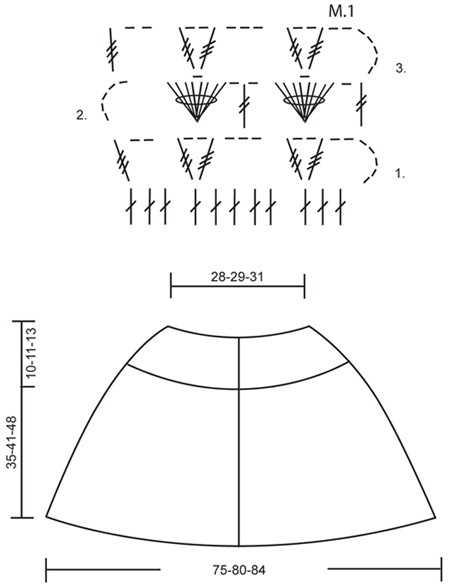
|
||||||||||||||||
Have you finished this pattern?Tag your pictures with #dropspattern #strandofpearlscape or submit them to the #dropsfan gallery. Do you need help with this pattern?You'll find 7 tutorial videos, a Comments/Questions area and more by visiting the pattern on garnstudio.com. © 1982-2025 DROPS Design A/S. We reserve all rights. This document, including all its sub-sections, has copyrights. Read more about what you can do with our patterns at the bottom of each pattern on our site. |
||||||||||||||||







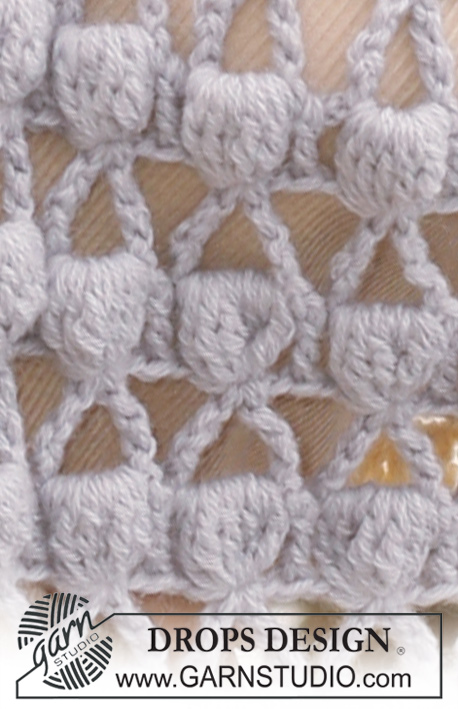



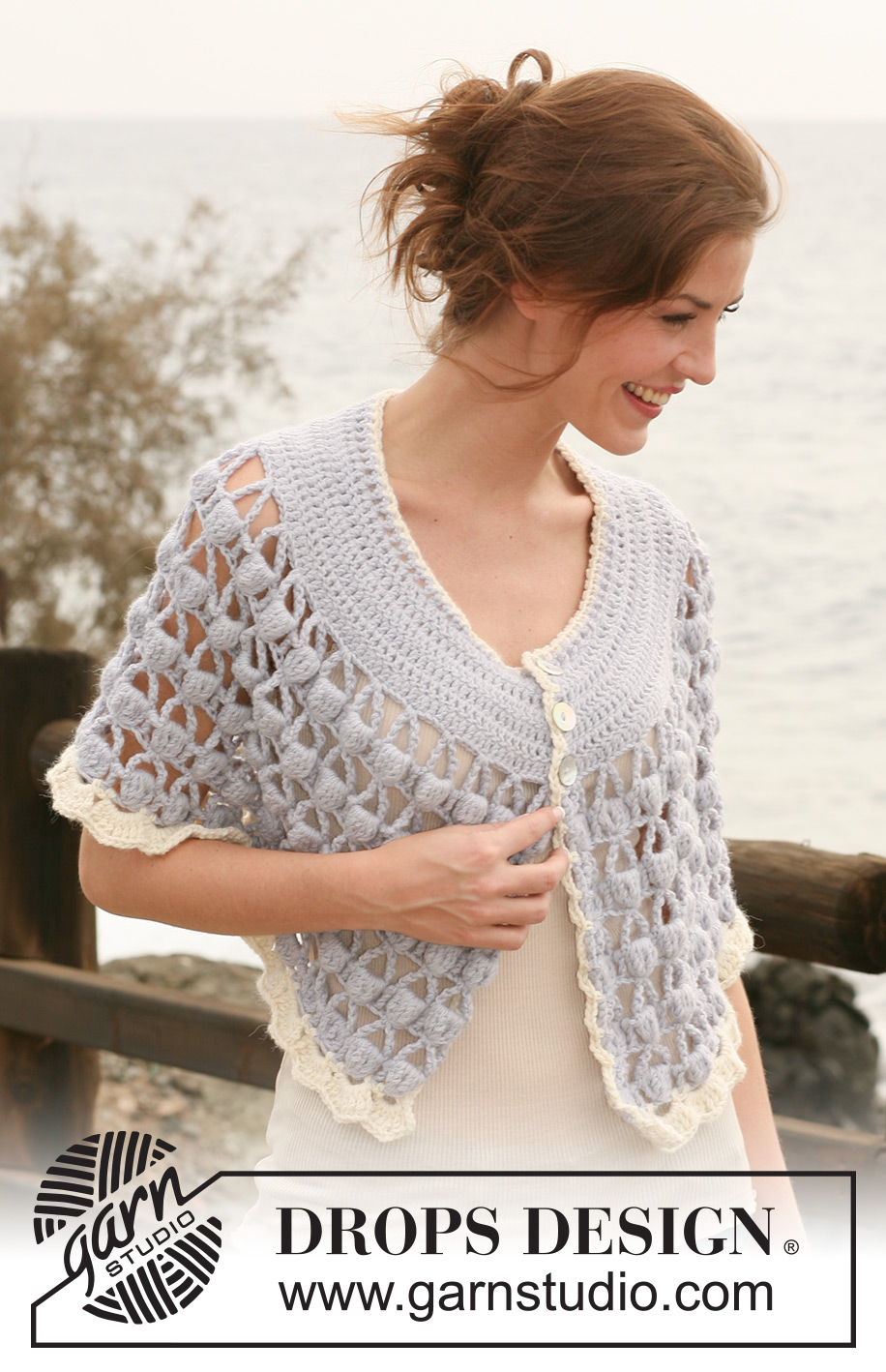

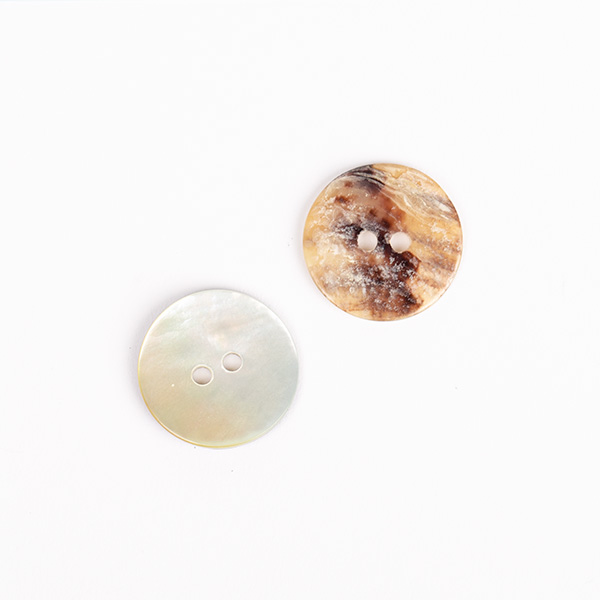




































Post a comment to pattern DROPS 119-30
We would love to hear what you have to say about this pattern!
If you want to leave a question, please make sure you select the correct category in the form below, to speed up the answering process. Required fields are marked *.